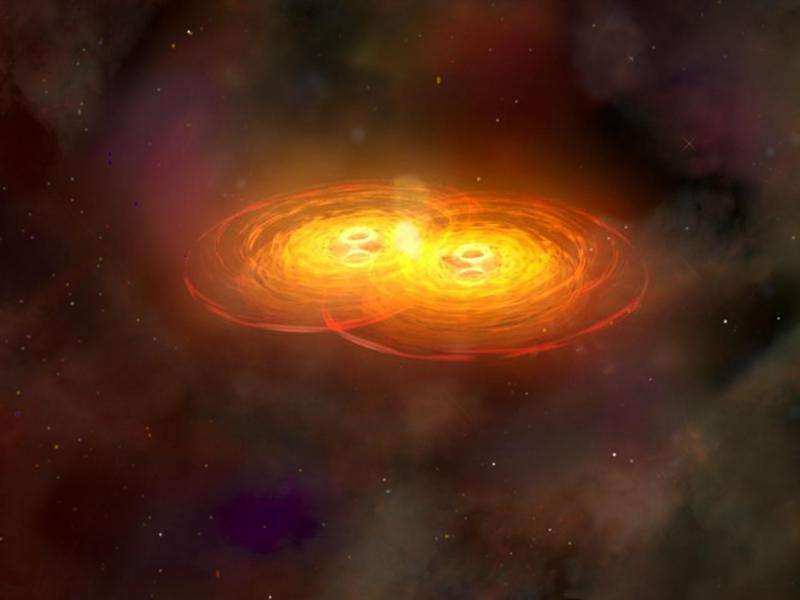An artist’s concept of two colliding black holes, in the process of merging. Credit: NASA / CXC / A. Hobart.
(Phys.org)—PKS 1302-102 is one of the few known quasars with a pair of black holes within its accretion disc. It is also a curious case for astronomers as it will produce a powerful explosion when these two black holes merge. The scientists trying to determine the scale of this merger estimate that it could result in an enormous release of energy.
"The result will be an enormous release of energy, roughly equivalent to millions of supernovae, in the form of gravitational waves," Matthew Graham of the California Institute of Technology (Caltech), one of the co-discoverers of PKS 1302-102, told Phys.org.
The quasar is in its final phase of the merging process. It could help us predict what the final stages of a black hole merger look like or how long the process might take. This is the so-called "final parsec problem", yet unsolved, as all theoretical models failed to explain the process.
Graham and his colleagues at Caltech, using the Catalina Real-Time Transient Survey, detected a strong, smooth periodic signal when observing PKS 1302-102 in optical and infrared light. Periodic signal was something that scientists haven't seen before in a quasar, so they suggest that it means the presence of a pair of supermassive black holes.
"In January 2015, we reported the detection of a five-year periodic signal in twenty years of optical data from PG1302-102 in Nature. We offered a number of possible physical mechanisms but they all required a supermassive black hole binary as the basic hypothesis," Graham explained.
"It is a periodic variation, not a flickering, which is random. It happens on all wavelengths that we can probe, not just in infrared. It was discovered in the visible light first," George Djorgovski of Caltech, also one of the co-discoverers of the quasar, told Phys.org.
He revealed that a number of subsequent papers have come out this year supporting their interpretation of the data. For example, a recent Nature paper from D'Orazio, Haiman and Schiminovich, where they found ultraviolet periodicity in archival data, suggesting that the relativistic motion of the two orbiting black holes is causing the periodic signal.
"The infrared signal is showing the same periodicity as the optical and ultraviolet and is further evidence supporting the supermassive black hole binary interpretation," Graham noted.
As we wait for the outcome of the merger of two supermassive black holes in PKS 1302-102, the scientist calculate that it has already happened. That's because the quasar is located approximately 3.5 billion light years from Earth and they estimate that the merger took place about 3.39 billion years ago. If so, the light from that event will arrive here in at least 100 million years.
However, the scientists speculate that this merger might also lead to the ejection of the newly merged black hole from the galaxy.
Whatever the outcome would be, this event could be a great and invaluable source of information about gravitational waves. Binary black holes are considered to be the strongest known sources of gravitational waves in the universe. If they merge, it could give us the best opportunity to directly detect such waves. The scientists will of course keep an eye on this quasar, performing observations in different wavebands.
"We have ongoing monitoring of this object, both photometrically and spectroscopically, and intend observations at other wavebands," Graham said.
More information: References:
—Daniel J. D'Orazio et al. Relativistic boost as the cause of periodicity in a massive black-hole binary candidate, Nature (2015). DOI: 10.1038/nature15262
Journal information: Nature
© 2015 Phys.org























